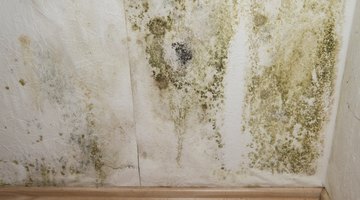How to Kill Mold in Walls
When you see mold growing on your walls -- especially black mold -- you have to get ready for the probability of more growing behind them, and the reason is often a leak. Before you undertake the mold remediation job yourself, consider the size of the problem -- if the mold covers much more than 10 square feet, the U.

S. Environmental Protection Agency recommends getting professional help. Once the job starts, you'll understand the reason for this recommendation.
Discard Affected Drywall and Insulation
When you see a black mold infestation, the first order of business is to get behind the wall to find the source of the moisture the mold is feeding on. To do this, you'll have to remove and discard the damaged drywall and insulation. Prepare for the job by sealing off the room where you're working and equipping yourself with a respirator, rubber gloves, protective clothing and enough garbage bags to hold the moldy material. Trace a rectangle that encloses all the mold, and cut around it with a drywall saw and utility knife. Pull off the drywall, remove all the insulation behind it and bag everything.
Find the Leak and Stop It
Now that you're down to the framing, you should be able to find the leak and stop it. In some cases, the source of the leak may not be obvious -- moisture may be seeping through poorly sealed concrete walls or footings -- but it's essential to find it and address it, or the mold will return. Your search for the leak may reveal more extensive mold damage than you expected. Be sure to remove all the blackened or wet drywall and insulation you find so you don't have to come back and do the mold remediation job again.
Scrub Off the Mold
Before you treat it for mold, inspect the framing to make sure it hasn't rotted; dry rot and other wood-eating fungi also thrive in moist environments. If you find rot, dig it out with a chisel and fill the wood with epoxy filler; you may have to replace some framing if it's too damaged to repair. You're now ready to remove the mold. The EPA recommends that you use a solution of detergent and water, and the Centers for Disease Control and Prevention recommends a solution of 1 part bleach for every 10 parts water. Either way, scrub off all the mold with a sponge and scrub brush, and use a toothbrush to get into areas that are difficult to reach.
Treat Wood With Boric Acid
Let the framing dry thoroughly after you clean off the mold; you may have to ventilate it with a fan, heat it with a heater or both if the wall is in a cool, humid room. Once you're sure everything is is dry, treat the wood with boric acid, which kills any spores that remain and prevents future growth. An easy way to make sure you cover all the wood is to make a paste with boric acid and water and apply it with a paintbrush, and then let it dry. As an alternative, paint the wood with a primer that contains a mildewcide.
The Drip Cap
- When you see mold growing on your walls -- especially black mold -- you have to get ready for the probability of more growing behind them, and the reason is often a leak.
- Pull off the drywall, remove all the insulation behind it and bag everything.
- Now that you're down to the framing, you should be able to find the leak and stop it.
- In some cases, the source of the leak may not be obvious -- moisture may be seeping through poorly sealed concrete walls or footings -- but it's essential to find it and address it, or the mold will return.
- You're now ready to remove the mold.
- As an alternative, paint the wood with a primer that contains a mildewcide.
References
Writer Bio
Chris Deziel has a bachelor's degree in physics and a master's degree in humanities. Besides having an abiding interest in popular science, Deziel has been active in the building and home design trades since 1975. As a landscape builder, he helped establish two gardening companies.
Photo Credits
- HandmadePictures/iStock/Getty Images
- HandmadePictures/iStock/Getty Images
More Articles


